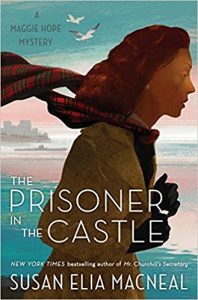The Spy Who Knew Too Much: Researching and Writing The Prisoner in the Castle
By Susan Elia MacNeal
At the end of The Paris Spy, the seventh novel in the New York Times-bestselling and Edgar-nominated Maggie Hope series, our plucky heroine finds herself in a predicament—she’s a British secret agent who knows too much about D-Day. What happened in real life, I wondered, to the spies who knew too much?
I’d heard rumors of a internment camp for secret agents like Maggie, and when I began talking to veterans and reading more, I learned it was true. Yes, Britain did indeed have a prison for agents thought to be a liability during the Second World War. Those agents were kept in a sprawling 18th century lodge in the western highlands of Scotland, under guard but given significant freedom and liberties, until the end of the war.
A prison camp. In a manor house. In the highlands of Scotland. How wonderful! I knew then that Maggie’s adventures there would be the subject of the next book, THE PRISONER IN THE CASTLE.
 But how does an author go from turning historic fact into fiction? Well, I began by looking at the real-life house where the prisoners were kept—Inverlair Lodge, located in Inverlair, Scotland, near the Spean Bridge. (Fun fact: Inverlair Lodge was also the inspiration for the television show, The Prisoner.)
But how does an author go from turning historic fact into fiction? Well, I began by looking at the real-life house where the prisoners were kept—Inverlair Lodge, located in Inverlair, Scotland, near the Spean Bridge. (Fun fact: Inverlair Lodge was also the inspiration for the television show, The Prisoner.)
In the book British Intelligence: Secrets, Spies and Sources, published by The National Archives, I learned: “Those placed there were generally foreign nationals and although they were housed in some comfort and could leave during the day to mix with locals, the situation naturally caused frustration… Some of the failed agents had difficult personalities, others were physically unsuitable for secretive work.”
How could an author of historical mysteries resist such a setting?
Alas, when I tried to plan a trip to visit Inverlair Lodge, I learned that it was off-limits to the public. It was also, to my eye, not atmospheric enough.
So I decided to take the idea, but look further for inspiration for Maggie Hope’s prison. After much research, I finally found Kinloch Castle, on the Isle of Rum, one of the Small Isles off the west coast of Scotland. This is it! I remember thinking when I saw the photograph of the extravagant fortress.
 Kinloch Castle looked fascinating, so I decided to visit in person. Coincidentally, it was close to Arisaig House, on the western coast of Scotland, the paramilitary headquarters of the British secret agents, where I’d set much of The Prime Minister’s Secret Agent, Maggie Hope #4. Arisaig House was now a beautiful hotel, run by a lovely family who’d taken great care of me when I’d visited to research that previous novel. And so I used Arisaig House Hotel as my home base to explore Kinloch Castle.
Kinloch Castle looked fascinating, so I decided to visit in person. Coincidentally, it was close to Arisaig House, on the western coast of Scotland, the paramilitary headquarters of the British secret agents, where I’d set much of The Prime Minister’s Secret Agent, Maggie Hope #4. Arisaig House was now a beautiful hotel, run by a lovely family who’d taken great care of me when I’d visited to research that previous novel. And so I used Arisaig House Hotel as my home base to explore Kinloch Castle.
And so, from the nearby town of Mallaig, I took the ferry to Rum, and spent the day wandering around the island (now a nature preserve) and also the Castle, really a late Victorian manse and not an actual medieval castle. It was built as a summer residence and shooting estate for Sir George Bullough, a textile tycoon from Lancashire, and completed in 1900.
The Kinloch Castle is, in a word, ugly. Architecturally, it has no beauty, grace, proportion, or harmony. The imported red stone used is garish and out of place on the island. And inside is even worse. Décor in scarlet and black features a relentless amount of taxidermy and violent works of art. As an estate (especially compared to the Arts and Crafts-era Arisaig House), it was dark and creepy. But to an author of historic mysteries, it was pure inspiration!
I’d read the book, Eccentric Wealth: the Bulloughs of Rum, by Alastair Scott before I went—but nothing had prepared me for the dreadful faded grandeur of the enormous castle in reality. When I took the official tour, given by the Scottish National Heritage, our guide—one of Rum’s twenty-something full-time residents—was a garrulous fellow. I don’t know if the tales he told are true or not, but they’re definitely part of island lore, handed down through the generations. So I learned several things about the castle that were not included in the book or any of the written materials.
 For instance, in the grand ballroom, there was an orchestra balcony that overlooked the parquet floor. “Look up,” our guide told us. “Do you see that curtain? Why do you think there’s a curtain?” Sure enough, a moth-eaten velvet curtain was pulled to one side, although it easily could be pulled to close off the balcony.
For instance, in the grand ballroom, there was an orchestra balcony that overlooked the parquet floor. “Look up,” our guide told us. “Do you see that curtain? Why do you think there’s a curtain?” Sure enough, a moth-eaten velvet curtain was pulled to one side, although it easily could be pulled to close off the balcony.
I was puzzled. Wouldn’t the curtain muffle the sound of the sound of the orchestra?
“It was so that no one could see the goings on down on the dance floor, if you get my meaning,” said our guide.
Just in case we were being slow, he also showed us the dumb waiters. “So food and drink could be passed to the guests without servants having to enter.”
Oh.
“And if you look up, you’ll notice the windows are quite high. So no one could see in.”
Oh.
Oh, my.
So that bit of information, not included in any of the written material, became the backstory of The Prisoner in the Castle. Of course that’s why I renamed the Castle and the island and the owners—because I wanted to lean into that—and the best way to do that is to make it completely fictional. And so what I knew about the actual Bulloughs of Rum was the inspiration for the fictional characters I created, the Killochs of Scarra.
And somehow, through research, reading, and writing, the two ideas—of the World War II secret agents imprisoned in Scotland and this island off the coast built by sex-crazed rich merged—and what emerged was The Prisoner in the Castle, an Agatha Christie-esque “closed door” mystery, which incorporates both real life stories, but is truly fiction.
I hope you enjoy reading The Prisoner in the Castle as much as I loved researching and writing it.
—
Susan Elia MacNeal is the author of the ongoing New York Times-bestselling and Edgar-nominated Maggie Hope mystery series, which began with Mr. Churchill’s Secretary. The Prisoner in the Castle, #8, will be published in trade paperback on July 30, 2019 and the next novel in the series, The King’s Justice, is set to be published on February 4, 2020.
—
Susan Elia MacNeal
Brooklyn, New York
www.susaneliamacneal.com
A series of baffling murders among a group of imprisoned agents threatens the outcome of World War II in this chilling mystery from the New York Times bestselling author of Mr. Churchill’s Secretary.
November, 1942. World War II is raging, and former spy Maggie Hope knows too much: what the British government is willing to do to keep its secrets, who is lying, who the double-crossers are. She knows exactly who is sending agents to their deaths. These are the reasons Maggie is isolated on a remote Scottish island, in a prison known as Killoch Castle. When one of her fellow inmates drops dead in the middle of his after-dinner drink—he’s only the first. As victims fall one by one, Maggie will have to call upon all her wits and skills to escape—not just certain death . . . but certain murder. For what’s the most important thing that Maggie Hope knows? She must survive.
Praise for The Prisoner in the Castle
“The colonel sums it up best on page ten: ‘If you take a pretty girl and teach her how to kill, it can cause problems.’ Not just problems—electrifying action and nonstop surprises. I loved this book!”—R. L. Stine, author of the Goosebumps and Fear Street series
“Another literary tour de force . . . From the book’s perfectly calibrated plot to its incisively etched characters, everything is handled with perfect finesse by the author.”—Poisoned Pen Newsletter
“One pleasure of a mystery series is connecting with a character that changes and grows with each novel. . . . Maggie’s intelligence and loyalty to the war effort continue to evolve in [Susan Elia] MacNeal’s series. . . . Solid twists keep the plot of The Prisoner in the Castle churning until the surprise finale.”—Associated Press
“A mystery . . . tailor-made for readers in the post-election, #MeToo era. . . . If you love a tricky puzzle that requires you to keep track of multiple alibis over time, this is your summer read.”—The Washington Post
“Evocative.”—Publishers Weekly
“MacNeal uses [Agatha] Christie’s And Then There Were None as a framework for a character-driven mystery/thriller that successfully emulates the original.”—Kirkus Reviews
Penguin Random House
Available in trade paperback July 30, 2019
THE KING’S JUSTICE
Penguin Random House
Available in hardcover February 4, 2020
Category: Contemporary Women Writers, On Writing

























